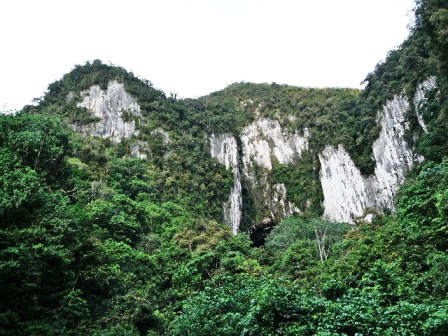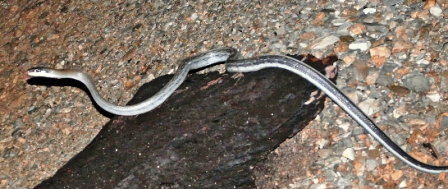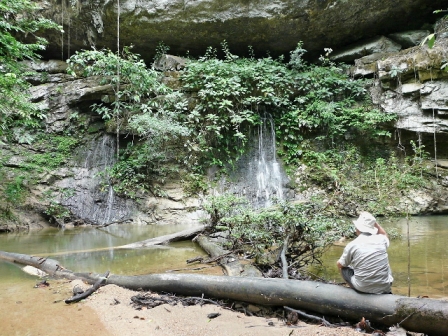|
Dec 20 2008
The small Fokker 50 plane took off from Miri and flew low enough that we
got a good view of the land below us. We flew over field after field of
Palm trees grown for their oil. The plane flew. We followed a broad,
muddy river with unbelievable twists and turns through jungle forests to
the hills surrounding Gunung Mulu National Park, our destination for the
next three days. We had a choice of transport to get to Mulu. We could
take two 4 hour fast boat rides and a 1 1/2 hour longboat ride to the
park or we could have a scenic 1/2 hour plane ride for not much more
money. After speaking to an Aussie man who made the long boat trip with
his young son, I think we made the right choice.
Mulu NP is a 529
sq km Unesco-listed site that is one of the most popular destinations in
Borneo. The attractions are its mountains to climb and its caves to
explore. We passed up hiking to the top of Mulu peak, a four day hike,
and the Pinnacles, a tough three day hike. We have decided we are past
the point of choosing a multi-day hike where we have to carry all our
own gear and food. We chose to visit the caves that riddle the limestone
mountain range within Mulu.
 The majority of tourists in the park
visit the Show Caves inside the sheer limestone cliffs near the park HQ.
One half-day walk visits the Deer and Lang's Caves and another half-day
walk includes the Wind and Clearwater Caves. For the more adventurous
there are additional cave explorations to do but we ran out of time. Our
morning flight allowed us to visit Deer and Lang's Caves with a guide
that afternoon. It is a 3 km walk along well maintained boardwalks to
the entrance of the caves. These interconnected caves are 2160 M long
and 220 M deep, forming the world's largest cave corridor. Both caves
had huge caverns filled with stalactites and stalagmites of every shape
and size. Since it is the monsoon season with daily rainstorms, water
comes through the roof in a continual stream at several points. Deer
Cave has two artificial looking downspouts, called "showerheads". All
you needed was some shampoo to wash your head under one of these spouts. The majority of tourists in the park
visit the Show Caves inside the sheer limestone cliffs near the park HQ.
One half-day walk visits the Deer and Lang's Caves and another half-day
walk includes the Wind and Clearwater Caves. For the more adventurous
there are additional cave explorations to do but we ran out of time. Our
morning flight allowed us to visit Deer and Lang's Caves with a guide
that afternoon. It is a 3 km walk along well maintained boardwalks to
the entrance of the caves. These interconnected caves are 2160 M long
and 220 M deep, forming the world's largest cave corridor. Both caves
had huge caverns filled with stalactites and stalagmites of every shape
and size. Since it is the monsoon season with daily rainstorms, water
comes through the roof in a continual stream at several points. Deer
Cave has two artificial looking downspouts, called "showerheads". All
you needed was some shampoo to wash your head under one of these spouts.
The reason the visit to Deer Cave is scheduled for the afternoon is
to time the end of the visit with the daily exodus of the two million
bats that roost in the roof. There are 12 different species of bats
living in the caves. They wake from there resting spots at dusk to
gather in swarms before flying into the jungle to feast on insects. Near
the entrance to the caves is an information center where everyone
congregates to watch this phenomenon. There were good posters giving
background information and large TV screens to watch the activity of the
bats transmitted by remote cameras inside the cave. We waited patiently
for the bats to appear. We could see them stirring from their roosts but
they were not congregating at the entrance of the cave. Finally we had
to give up. It was getting dark and even if the bats did decide to make
their move, we would not be able to distinguish them in the dark. We
walked back to our lodging, pleased with our cave visit but disappointed
not to see the Bat Exodus. There was no alternative but to return at the
end of the next day, which we did to no avail. It rained as we waited
for the exodus and the bats won't come out in the rain, whimpy souls! We
even returned for our third and final night but once again it rained and
the bats were a no-show. At least all that walking gave us a good
appetite for dinner. The personnel at the Park HQ told us that the bats
often miss a night if the conditions are not just right. They can even
miss a week or more, living on their own body fat and lowering their
body functions until they are in a semi-hibernation state. They had
missed 6 or 7 days by the time we left so we just have to believe the
stories of the mass exodus. They did not perform for us.
Wind and
Clearwater Caves are a bit farther from the Park HQ. We took a 30 minute
longboat ride up the Melinau River, stopping on the way to visit the
souvenir stands at a small Penan settlement. The Malaysian Government
has decided that the nomadic Penan people would be better served if they
lived in permanent settlements as logging and civilization are depleting
their traditional hunting grounds. This had not been an unqualified
success. The villagers are still living in poverty and there is little
employment. The men are allowed to hunt in the Mulu forests but they
must travel long distances to get any game. The women earn a little
money making and selling crafts to Mulu tourists. The quality of the
beading and rattan weaving was good but we were not there to buy
souvenirs. We were on a cave expedition. We left with no purchases.
The openings to the interconnected Wind and Clearwater Caves was on the
side of a sheer limestone cliff, reached by a staircase of 200 steps.
The Clearwater Cave system totals more than 51 km with more being
discovered every year. We explored only a very small part. The smaller
Wind Cave gets its name from the cooling breeze flowing through its
cavern. There were not as many stalactites and stalagmites as the Deer
and Lang's Caves, but much of the cave walls were covered by a soft
white surface called Moonmilk, caused by a bacteria. An underground
river runs through Clearwater Cave and spills out to form a natural
swimming pool at the cave entrance. Several people, but not us as we
didn't have our bathing suits with us, had a refreshing swim at the end
of the cave walk.
 Our highlight was turning a corner on the
walkway through the cave to discover a grey-green Racer cave snake right
beside our path. We all rushed to take its picture before it slowly
escaped in the rocks. It lives on bats, frogs and swiftlets that live in
the caves and is harmless to humans. Our highlight was turning a corner on the
walkway through the cave to discover a grey-green Racer cave snake right
beside our path. We all rushed to take its picture before it slowly
escaped in the rocks. It lives on bats, frogs and swiftlets that live in
the caves and is harmless to humans.
At the end of one of the
boardwalks was a set of steps leading down to the underground river.
This is the end of one of the adventure cave walks between Wind and
Clearwater caves. Our guide said the waters of the river are reputed to
be a restorative to the skin, taking years off your face and body. We
all had to splash some of the water on ourselves, but I regret to say I
still look the same. The fountain of youth is not here.
There is
an alternate route to the Clearwater Caves. Rather than take the boat
you can walk back. The path goes up and down two more sets of stairs and
through another small cave appropriately called Moon Milk Cave. It took
us 1 1/2 hours to walk back but it was a pleasant way to return.
Another morning we followed a well-marked trail to see the Puka
waterfalls. It was a peaceful rainforest walk with a small but pretty
double waterfall descending from limestone cliffs into a small river. We
could hear bird song but couldn't see any through the thick foilage. We
did see a large squirrel jump from tree to tree and I had my first
leeching. I brushed past some leaves beside the path, looked down at my
leg and saw two worm-like creatures on me. One turned out to be a
harmless inch worm but the other was a leech, lunching on my blood. It
took quite a bit of effort to dislodge it from the back of my knee but I
was lucky it was a small brown leech that has no sting. The larger Tiger
leeches sting like a bee, not an experience I would welcome.

Puka Waterfalls |

Canopy Walk |
We
had time the last day to visit the canopy walk. A 483 M long walkway has
been constructed 15 to 20 M above the rainforest floor. You do get a
different perspective from that level in the trees. The walkway is
divided into 14 sections separated by landings built around trees. It is
quite safe. The walkway floor is only two boards wide but there were
cable railings and netted sides preventing any possibility of a fall.
Workmen were busy adjusting cables around one of the trees. Our guide
said that the attachment of the cables to the tree is changed every six
months minimizing damage to the tree and allowing for the natural growth
of the tree. |

 Our highlight was turning a corner on the
walkway through the cave to discover a grey-green Racer cave snake right
beside our path. We all rushed to take its picture before it slowly
escaped in the rocks. It lives on bats, frogs and swiftlets that live in
the caves and is harmless to humans.
Our highlight was turning a corner on the
walkway through the cave to discover a grey-green Racer cave snake right
beside our path. We all rushed to take its picture before it slowly
escaped in the rocks. It lives on bats, frogs and swiftlets that live in
the caves and is harmless to humans.